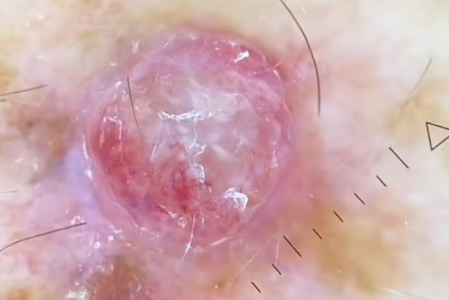You won’t believe what this skin cancer doctor found—could you spot a melanoma that doesn’t look like a mole?
By
- Replies 5
When it comes to looking after our skin, most of us have been told the same thing for decades: keep an eye on your moles. If they change shape, colour, or size, get them checked. But what if we told you that not all melanomas—the most dangerous form of skin cancer—look like moles at all? In fact, some can appear as innocent little bumps, and missing them could be deadly.
That’s the sobering message from Dr John O’Bryen, a leading GP at Australia’s Body Scan Skin Cancer Clinic, who recently shared a jaw-dropping video online. In it, he reveals what he calls the 'worst melanoma' he’s ever seen—and it’s not what you’d expect.
Not All Melanomas Are Moles: The Shocking Truth
Dr O’Bryen’s video, which has racked up over 100,000 views, shows a close-up of a red, raised bump on a patient’s arm. No dark, irregular mole in sight—just a small, firm, rapidly growing lump. 'Not all melanomas are brown and black,' he warns. 'Nodular melanomas grow quickly and cause the greatest fatality.'
This type of melanoma, known as nodular melanoma, is the second most common form and is notorious for its speed and deadliness. Unlike the classic flat, dark mole, nodular melanomas often appear as new, elevated bumps that can be red, pink, or even skin-coloured. They can develop anywhere on the body and are most commonly found in people in their 40s and 50s—but no one is immune.
What Should You Look For?
We’re all familiar with the ABCDEs of melanoma:
But Dr O’Bryen’s case is a stark reminder that not all melanomas tick these boxes. The patient’s bump was about 4mm wide, red, and had grown quickly. Under magnification, Dr O’Bryen spotted a patchy network of blood vessels and white lines—classic signs of skin cancer, but not ones most of us would recognise.
Why Early Detection Is Everything
The scary part? Nodular melanomas grow downwards into the deeper layers of the skin, making them more likely to spread if not caught early. The good news is that if detected soon enough, they can often be removed with a simple surgery under local anaesthetic.
Experts stress that any new or changing bump, lump, or spot on your skin—especially one that’s growing, firm, or looks different from your other spots—should be checked by a doctor. Even if it doesn’t look like a mole, don’t ignore it!
The Sunburnt Country: Why Aussies Need to Be Extra Careful
Australia has one of the highest rates of skin cancer in the world, thanks to our love of the great outdoors and our harsh sun. Melanoma is responsible for four out of five skin cancer deaths, and the numbers are rising. Cancer Research UK predicts that by 2040, there could be as many as 26,500 new cases of melanoma diagnosed each year.
But here’s the kicker: up to 87 per cent of skin cancer cases could be prevented. Most are caused by overexposure to ultraviolet (UV) rays from the sun or sunbeds. That means simple sun safety habits—like wearing a hat, covering up, seeking shade, and using SPF 30+ sunscreen—can make a massive difference.
New Hope: Revolutionary Treatments on the Horizon
There’s some good news, too. Patients with the deadliest types of skin cancer are set to get fast-tracked access to a revolutionary new cancer vaccine on the NHS. This needle-free injection is custom-built to help stop melanoma from returning by boosting the immune system’s response to cancer cells. While immunotherapy already helps about half of melanoma patients, this new vaccine could be a game-changer for those who don’t respond to current treatments.
Let’s Look Out for Each Other
Melanoma doesn’t always play by the rules, and neither should we when it comes to our health. If you spot something odd, don’t wait—get it checked. It could save your life or the life of someone you love.
Credit: TikTok

Have you or someone you know had a skin cancer that didn’t look like a typical mole? How do you keep on top of your skin checks? Share your experiences and tips in the comments below—let’s help keep our community safe and sun smart!
Read more: 'I feel like a walking miracle’: Groundbreaking melanoma trial defies all odds
That’s the sobering message from Dr John O’Bryen, a leading GP at Australia’s Body Scan Skin Cancer Clinic, who recently shared a jaw-dropping video online. In it, he reveals what he calls the 'worst melanoma' he’s ever seen—and it’s not what you’d expect.
Not All Melanomas Are Moles: The Shocking Truth
Dr O’Bryen’s video, which has racked up over 100,000 views, shows a close-up of a red, raised bump on a patient’s arm. No dark, irregular mole in sight—just a small, firm, rapidly growing lump. 'Not all melanomas are brown and black,' he warns. 'Nodular melanomas grow quickly and cause the greatest fatality.'
This type of melanoma, known as nodular melanoma, is the second most common form and is notorious for its speed and deadliness. Unlike the classic flat, dark mole, nodular melanomas often appear as new, elevated bumps that can be red, pink, or even skin-coloured. They can develop anywhere on the body and are most commonly found in people in their 40s and 50s—but no one is immune.
What Should You Look For?
We’re all familiar with the ABCDEs of melanoma:
- A - symmetry
- B - order irregularity
- C - olour variation
- D - iameter over 6mm
- E - volving (changing over time)
But Dr O’Bryen’s case is a stark reminder that not all melanomas tick these boxes. The patient’s bump was about 4mm wide, red, and had grown quickly. Under magnification, Dr O’Bryen spotted a patchy network of blood vessels and white lines—classic signs of skin cancer, but not ones most of us would recognise.
Why Early Detection Is Everything
The scary part? Nodular melanomas grow downwards into the deeper layers of the skin, making them more likely to spread if not caught early. The good news is that if detected soon enough, they can often be removed with a simple surgery under local anaesthetic.
Experts stress that any new or changing bump, lump, or spot on your skin—especially one that’s growing, firm, or looks different from your other spots—should be checked by a doctor. Even if it doesn’t look like a mole, don’t ignore it!
The Sunburnt Country: Why Aussies Need to Be Extra Careful
Australia has one of the highest rates of skin cancer in the world, thanks to our love of the great outdoors and our harsh sun. Melanoma is responsible for four out of five skin cancer deaths, and the numbers are rising. Cancer Research UK predicts that by 2040, there could be as many as 26,500 new cases of melanoma diagnosed each year.
But here’s the kicker: up to 87 per cent of skin cancer cases could be prevented. Most are caused by overexposure to ultraviolet (UV) rays from the sun or sunbeds. That means simple sun safety habits—like wearing a hat, covering up, seeking shade, and using SPF 30+ sunscreen—can make a massive difference.
New Hope: Revolutionary Treatments on the Horizon
There’s some good news, too. Patients with the deadliest types of skin cancer are set to get fast-tracked access to a revolutionary new cancer vaccine on the NHS. This needle-free injection is custom-built to help stop melanoma from returning by boosting the immune system’s response to cancer cells. While immunotherapy already helps about half of melanoma patients, this new vaccine could be a game-changer for those who don’t respond to current treatments.
Let’s Look Out for Each Other
Melanoma doesn’t always play by the rules, and neither should we when it comes to our health. If you spot something odd, don’t wait—get it checked. It could save your life or the life of someone you love.
Credit: TikTok
Key Takeaways
- Not all melanomas look like typical moles—some can appear as red, elevated bumps that grow quickly, so it’s important to monitor all changes to your skin, not just dark or oddly shaped spots.
- Nodular melanoma is the second most common type of melanoma in Australia, tends to grow fast and deeply, and often presents as a raised area anywhere on the body, especially in people in their 40s and 50s.
- Early detection is key—while the ABCDE checklist (asymmetry, border, colour, diameter, evolving) can help spot melanoma, skin changes outside of these should still be checked by a GP promptly.
- Up to 90 per cent of melanoma cases could be avoided by better sun safety, such as using SPF 30+ sunscreen, covering up, and avoiding sun exposure during peak UV times, while new treatments like melanoma vaccines are being introduced to help prevent recurrence in high-risk patients.
Read more: 'I feel like a walking miracle’: Groundbreaking melanoma trial defies all odds








